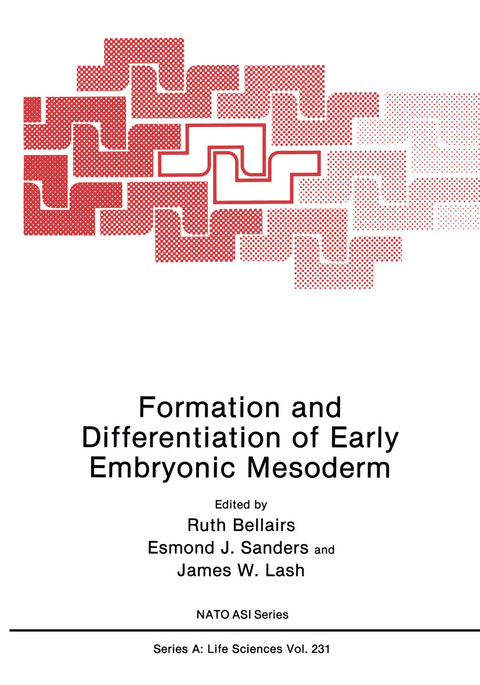
Formation and Differentiation of Early Embryonic Mesoderm
Springer-Verlag New York Inc.
978-1-4613-6531-0 (ISBN)
Mesodenn is a key tissue in early development. It is involved in the differentiation of almost every organ in the body, not merely as a structural component, but as an active participant in the establishment of diverse cell types. All mesodenn is derived from ectoderm. Its appearance signals the start of a significant new phase in the development of the embryo. At this time all three genn layers are now present and myriad sequences of cell and tissue interactions begin to occur which will eventually give rise to the entire embryo. The control of the growth and differentiation of the mesoderm is critical for the production of a normal individual. Indeed, disturbance of the patterning of the mesoderm or of its interaction with other tissues plays a critical part in the fonnation of most congenital anomalies. The main focus of this book is therefore on the establishment, divergence and specialisation of mesodermal derivatives. The central role of the mesoderm in development has long been appreciated and a wide literature exists on its activity in certain specialised situations. Recently, however, an impetus to its study has been provided by new approaches opened up through biotechnological advances. Many of these advances are reflected in the reports in this volume. Scientists from various disciplines have become drawn to mesodermal tissues, and this volume may help them find a framework within which their work will fit.
Mesoblast Anlage Fields in the Upper Layer of the Chicken Blastoderm at Stage 5V.- The Avian Marginal Zone and Its Role in Early Development.- Evidence for Stem Cells in the Mesoderm of Hensen’s Node and Their Role in Embryonic Pattern Formation.- Early Mesoderm Formation in the Mouse Embryo.- Mediolateral Intercalation of Mesodermal Cells in the Xenopus laevis Gastrula.- Differentiation Capabilities of the Avian Prechordal Head Mesoderm.- On the Differentiation and Migration of the Wolffian Duct in Avian Embryos.- The Neural Crest as a Model System to Study Modulations of Cellular Adhesiveness during Avian Embryonic Development.- Fibronectins and Embryonic Cell Migration.- Localization of Endogenous Lectins during Early Chick Development.- Induction and Pattern Emergence in the Mesoderm.- Segmentation and Compartments in the Vertebrate Embryo.- Glycosylation Modifiers and the First Cellular Migrations/Inductions in Early Chick Embryo.- Segmentally Regulated Patterns of Cell Death in the Hindbrain and Trunk of the Developing Chick Embryo.- A Monoclonal Antibody That Reacts with the Ventro-Caudal Quadrant of Newly Formed Somites.- Relations between Mesodermal and Neural Segmentation.- Somitic Mesoderm: Modulation of Chondrogenic Expression by Retinoic Acid.- Expression of Myogenic Factors in Somites and Limb Buds during Mouse Embryogenesis.- Role of Growth and Motility Factors in Early Avian Development.- The Role of Thresholds and Mesoderm Inducing Factors in Axis Patterning in Xenopus.- Roles for TGF?1 in Chick Embryo Cell Transformation.- Characteristics of the Precardiac Mesoderm in the Chick.- The Effects of Retinoic Acid on Early Heart Formation and Segmentation in the Chick Embryo.- Regulatory Role of Cell Adhesion Molecules in Early Heart Development.-Angiogenic Capacity of Early Avian Mesoderm.- Vascular Growth in the Extraembryonic Mesoderm of Avian Embryos.
| Erscheint lt. Verlag | 29.10.2012 |
|---|---|
| Reihe/Serie | Nato Science Series: A ; 231 |
| Zusatzinfo | VIII, 341 p. |
| Verlagsort | New York, NY |
| Sprache | englisch |
| Maße | 178 x 254 mm |
| Themenwelt | Naturwissenschaften ► Biologie ► Botanik |
| Naturwissenschaften ► Biologie ► Genetik / Molekularbiologie | |
| Naturwissenschaften ► Biologie ► Zoologie | |
| Naturwissenschaften ► Physik / Astronomie ► Angewandte Physik | |
| ISBN-10 | 1-4613-6531-7 / 1461365317 |
| ISBN-13 | 978-1-4613-6531-0 / 9781461365310 |
| Zustand | Neuware |
| Haben Sie eine Frage zum Produkt? |
aus dem Bereich


